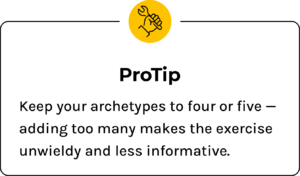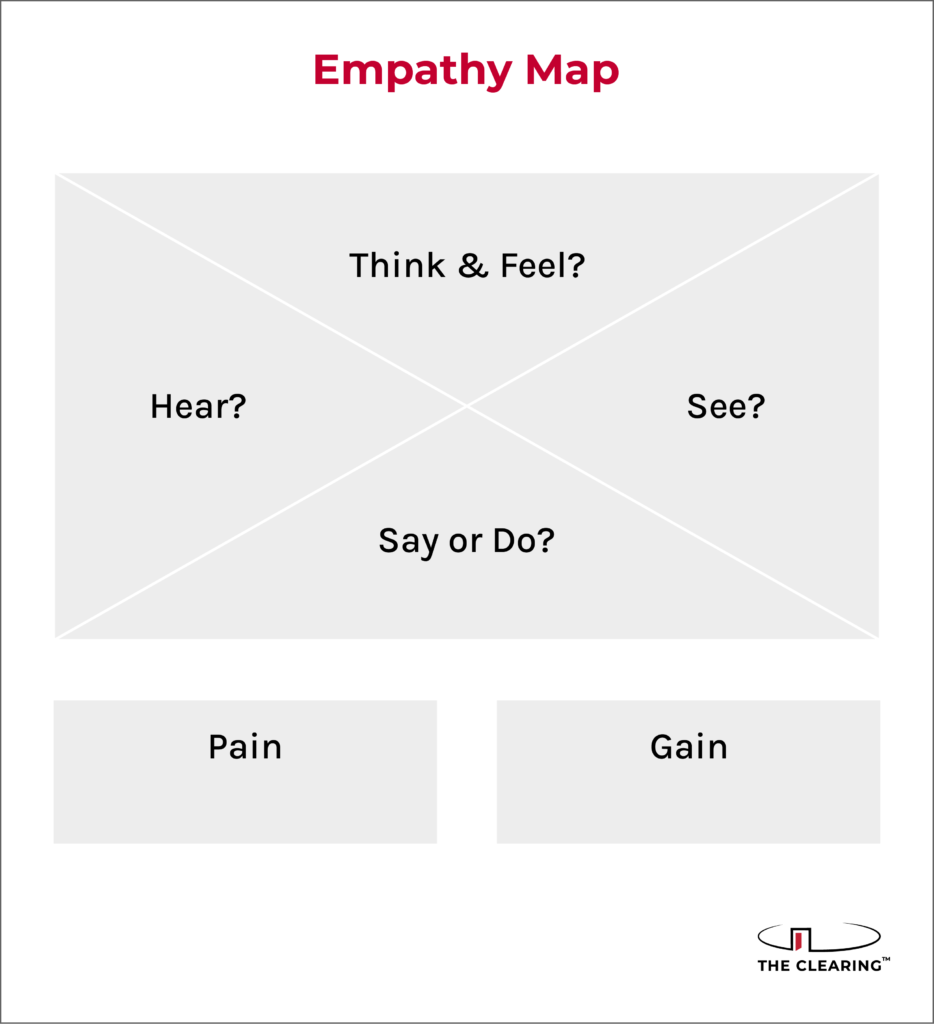We all know the old adage: change is hard. In large organizations, change becomes even harder. Change affects every person differently, making it difficult for leaders to predict how a proposed organizational transformation may be received. While cataloging every individual’s opinion on proposed change may prove unwieldy, there are tools leaders can use to more broadly anticipate reactions and plan accordingly. Today, we’ll cover one used frequently at The Clearing: Empathy Mapping.
What is an Empathy Map?
An empathy map is a tool that is commonly used to visualize and articulate what a particular type of person, user, or customer is saying, feeling, thinking, or seeing around a particular topic. Organizations often employ empathy maps when facets of the workplace are going to change for their employees. Such changes include implementing a new tool or technology, shifts in the way people work, returning to the physical office post-pandemic, or a big organizational announcement.
No matter the expected change, an empathy map’s purpose is to help you understand how the core personas within your organization are going to react to the information. This helps leaders better plan an effective rollout of the information.
Here at The Clearing, we find empathy maps particularly useful in facilitating smooth workplace transformations – especially as people begin returning to the physical office. For example, a leader may want their team in the office a certain number of days each week. While that may work for the leader, team members may have different expectations. An empathy map not only helps that leader see what the reaction to such an announcement may be, but it also allows them to put themself in their team members’ shoes.
How Do I Create an Empathy Map?
Step 1
The first step in creating an empathy map is to determine the groups you are going to use to sort people into. At The Clearing, we call them archetypes – and during the pandemic, we used them to conduct our own empathy mapping exercise. In the early days of the pandemic, we mapped out how people might react if they were asked to come back to the physical office.
We identified four archetypes using the information we had available around the pandemic and anecdotal accounts from our team members. Here’s where we landed.
![]()
The Innovator. The person who gets a lot of energy out of new situations. They’re diving in and bringing things to the table to help advance the way we work in this environment.
![]()
The Worrier. The person who is scared by the unknown. Am I going to get sick? Am I going to lose my job if I don’t come into the office? What if I’m not successful working from home?
![]()
The Challenger. The person who no matter how much thought was put into a decision or change is always ready with a question or 10. This person is very vocal and not afraid to let you know they disagree or think they have a better solution.
![]() The Team Player. The person who is a model employee and champion of change. They’re going to be the first to join you in a given change.
The Team Player. The person who is a model employee and champion of change. They’re going to be the first to join you in a given change.
We recognized that these four groups didn’t cover every individual in the company, but did represent large cross-sections of our team. By examining these diverse perspectives, we were able to have an effective conversation about employee reactions to being asked to return to the physical office.

Step 2
Once you have your archetypes solidified, spend time with each of them. We recommend scheduling a leadership session and walking through an empathy map template for each of the archetypes you’ve defined with your leadership team. By following the map, you can consider answers to the same set of questions for each archetype.

When we went through our back-to-the-office exercise at The Clearing, we did exactly that. The map helps a leader determine not only what an archetype group may feel when asked to come back to the office, but what they may say to others about the proposed change and how the people surrounding them might influence their reaction. Here is a sample of the questions we considered:

Once you’ve filled out the map for a given archetype, take the answers and consider the pain and gain that person may experience if asked to come back to the office.

Step 3
When you put all the pieces together a leader gains a sense of how a person might react to the proposed change. It makes constructing a transformation plan that leverages the positives and accommodates the negatives much easier. For our worriers, we considered options such as vaccination requirements or continued work from home. For our innovators, we discussed how to involve them in planning for revamped ways of working in a changed in-office environment.
Empathy Maps in the Real World
When we work with clients on planning a transformation, we conduct this exercise early in the process. In some cases, a broad decision may have been made but the details are not yet set in stone. Empathy mapping at this point serves as a check on the proposed action and a jumping-off point for detailed planning.
For example, a company may make the broad decision to require employees to return to the office. Undertaking an exercise similar to what The Clearing did may expose potential flaws in that decision.
- Will requiring in-person work result in large-scale departures from the company?
- Will employee experience scores decline due to the loss in flexibility?
We recently partnered with a client who was discussing their own return to work. The leadership team was proud of their culture and values. They believed that maintaining that culture required in-person work. Walking them through an empathy mapping exercise helped them think outside their bubble and rebalance their desire for getting “back to normal” with the benefits their employees had realized in with increased flexibility.
We saw a lightbulb go on when leadership started to consider the positives their working mothers experienced from at-home work or the improved work-life balance of former 3-hour commuters. It became clear that their return-to-work plan would need to balance the pains and gains of the organization with the pains and gains of its people. In the end, empathy mapping helped leaders not only craft the right plan, but communicate it in a way that successfully mitigated many of the anticipated concerns of the workforce.
We Can Help
An empathy mapping exercise does not have to be formal; however, we find that using a neutral facilitator to conduct the session helps participants more effectively think outside of themselves. It also allows leaders to be fully present in the exercise instead of trying to guide the discussion and capture outputs.
If your organization is considering a big change, we can help you better prepare for both the desired outcome and the potential hiccups. Reach out to me at Kelly.Barlow@theclearing.com – I’d love to chat about how we can help.








 The Clearing’s Employee Experience
Improvement model, adapted from Itam
& Ghosh, 2020, focuses on three objectives:
The Clearing’s Employee Experience
Improvement model, adapted from Itam
& Ghosh, 2020, focuses on three objectives: 












